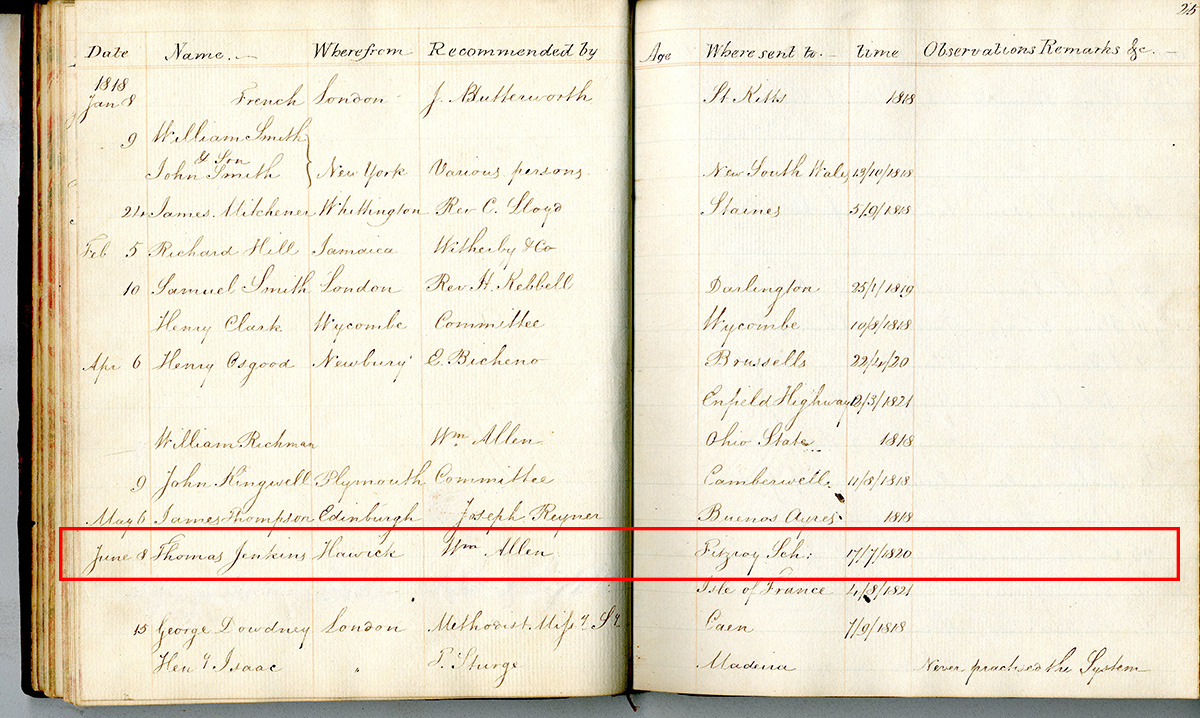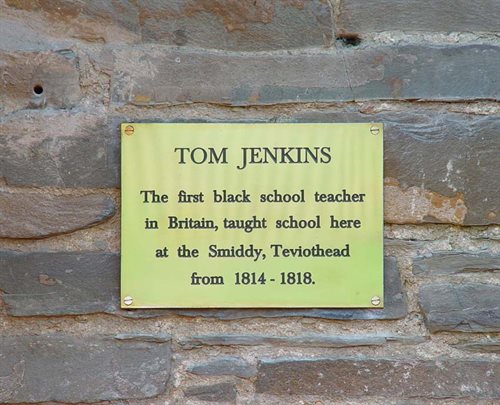From the Archives
To celebrate Black History Month, we look back on the life and career of Brunel alumnus Tom Jenkins, a man commonly thought to be Britain’s first black teacher.
Brunel is home to the archives of the British and Foreign School Society (BFSS), one of the world’s most important collections on 19th Century elementary education and teacher training.
The story of Tom Jenkins – whose real name we’ll probably never know – begins off the coast of West Africa aboard Captain James Swanson’s ship, The Prudence. The year is 1803.
How Tom came to be aboard The Prudence isn’t known for sure, but it’s thought that his father – probably a chief from what would now be modern-day Liberia or Sierra Leone – had asked Swanson to take his son to be educated in Britain.
Why the captain agreed we don’t know, but in May 1803, James Swanson and a young Tom Jenkins arrived in Liverpool and made their way north to Hawick in Scotland.
Just weeks later, Captain Swanson fell ill and died.
Whilst plenty of stories abound locally of Tom's good upbringing, he only re-enters the record books in 1814, at an interview with the high-ranking Heritors of the Parish of Cavers. [What’s a Heritor?]
Obviously impressed by Tom, the Heritors recommended to the Presbytery of Jedburgh – the local congregation – that they employ him as their schoolmaster in the border village of Teviothead. The Presbytery, however, refused him the position, still many decades away from being prepared to allow a man of 'pagan' birth to teach their young flock.
Unperturbed, local supporters of Tom, including the Heritors and the Duke of Buccleuch, decided to open a rival school in one of the village’s former blacksmiths. Tom Jenkins, still only in his late teens or early twenties, was installed as the schoolmaster.
The former smithy at Teviothead, which became Tom Jenkin’s first school. It’s said that he taught on the ground floor and lived in the loft. The site is now home to the Johnnie Armstrong Gallery. (Image:
CC by
Walter Baxter)
After a few apparently successful years in the post – during which time Tom also attended classes at the University of Edinburgh – he left Teviothead and set off south towards the big smoke of London.
On 8 June 1818 Tom arrived at Borough Road College in Southwark, where he enrolled himself onto the teacher training course with the backing of influential abolitionist Quaker, William Allen.
We know the exact date as the college was owned at the time by the British and Foreign School Society (BFSS), an organisation founded in 1808 by Christian social reformers to continue the work of education pioneer Joseph Lancaster.
BFSS continued to take an avid interest in Tom for the rest of his life, and archives including registers, testimonials and letters were kept.
The archives passed to the West London Institute of Higher Education – one of Brunel’s founding colleges – in 1976, when it took over the running of Borough Road College.
Tom reappears in the records in 1820, teaching professionally in London. A testimony from the time talks of the “zealous and able conduct of Thomas Jenkins in assisting in the organisation and establishment of a school at Pimlico”. The following year he was recorded as teaching at the Fitzroy Sabbath and Day School on Grafton Street in Fitzrovia.

Records from the BFSS Archives show the date Tom enrolled at Borough Road College. He was backed by William Allen, an influential abolitionist Quaker.
Although his teaching career in London seemed to be going well, in 1821 Tom’s gaze was drawn back towards Africa by an invitation from Sir Robert Townsend Farquhar, the Governor of Mauritius.
The pull must have been strong, as on 6 August of that year, Tom boarded the ship Columba at Gravesend and set sail for the small East African island. He never set foot on British soil again.
Ever keen to be teaching, Tom helped pass the three-month voyage by tutoring one of his fellow passengers – Prince Ratefy of Madagascar.
Mauritius was officially called Isle de France until 1810, when it passed from French to British hands. Map: Rigobert Bonne, 1770
By 1822, Tom was already being groomed for a senior teaching post in the colony, with a report from the BFSS saying that Tom had been sent “to the Isle of France where, under the protection of the benevolent Governor, he is at present employed in visiting and reporting upon the state of schools already established in that settlement. And after this object has been accomplished, he will take charge of a Model School.”
Tom took charge of his own school in January 1823, opening with just six pupils. Although the school was initially viewed with suspicion by the local population, by the time of the Governor’s visit that May, it had grown to 131 pupils: 56 girls and 75 boys. On Sundays, Tom also taught at St James Cathedral in Port Louis, the colony’s capital.
St James Cathedral, Port Louis, c.1912. Image: Public domain
In 1851, Tom wrote in a letter: “I am going on steadily in the prosecution of my important duties as teacher of the rising generation in this colony.
“Many of the children who have received their education in the school since its commencement in 1823 are now in respectable mercantile houses or Government offices. Some are in charge of schools under the Education Committee.”
One of the final records of Tom Jenkins’s life shows that in June 1858, he passed away. He was in his early 60s.
At the time of his death, Tom had been in the service of the colonial government of Mauritius for 37 years. He was survived by his wife Augustine Jenkins – a teacher in a local girls’ school – and their four children.
Despite his years of service, his widow was refused a pension.
Whilst we may never know Tom’s real name, or where he came from, we do know that he successfully wrote himself into the history books of two continents.
Still to this day, he is celebrated by a small plaque on the wall of the old smithy in Teviothead:
“Tom Jenkins. The first black school teacher in Britain, taught school here at The Smiddy, Teviothead from 1814 - 1818.”

Today Tom Jenkins is remembered with a plaque on the wall of his old school, at the Smiddy, Teviothead. (Image ©Kenneth Erik Moffatt)
This article was made possible with the generous help of the Johnnie Armstrong Gallery at the Smiddy in Teviothead. They kindly provided information and images in support of this article.
To see their great work, please visit www.thecelticgoldsmith.com
Reported by:
Phaedra Casey and Tim Pilgrim,
Media Relations
+44 (0)1895 268965
tim.pilgrim@brunel.ac.uk